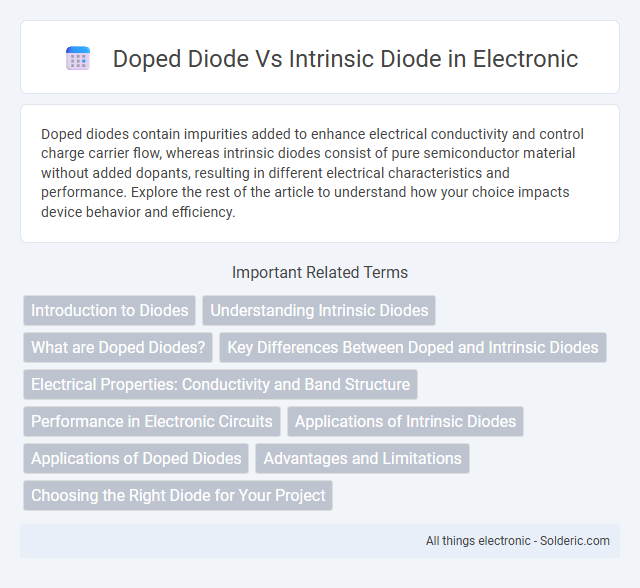Doped diodes contain impurities added to enhance electrical conductivity and control charge carrier flow, whereas intrinsic diodes consist of pure semiconductor material without added dopants, resulting in different electrical characteristics and performance. Explore the rest of the article to understand how your choice impacts device behavior and efficiency.
Comparison Table
| Feature | Doped Diode | Intrinsic Diode |
|---|---|---|
| Definition | Diode with intentionally added impurities to create p-n junction | Pure semiconductor diode without impurity doping |
| Material | Silicon or Germanium with dopants (e.g., Boron, Phosphorus) | Undoped Silicon or Germanium |
| Charge Carriers | Holes and electrons from doping create majority carriers | Thermally generated intrinsic carriers only |
| Conductivity | Higher due to doping-induced free carriers | Lower, limited by intrinsic carrier concentration |
| Forward Voltage Drop | Typically ~0.7V (Silicon) | Higher, less efficient conduction |
| Application | Rectifiers, switching, signal modulation | Rarely used alone, mainly in research or special sensors |
| Cost & Manufacturing | Standard and cost-effective production process | Complex, expensive due to purity requirements |
Introduction to Diodes
Doped diodes contain semiconductor materials with intentional impurities added to create p-n junctions, enhancing their electrical conductivity and enabling controlled current flow. Intrinsic diodes are made from pure semiconductor materials without any added impurities, resulting in higher resistance and lower conductivity compared to doped diodes. Your choice between doped and intrinsic diodes depends on the required electrical characteristics and application sensitivity.
Understanding Intrinsic Diodes
Intrinsic diodes consist of pure semiconductor materials without intentional impurity doping, resulting in a higher resistivity and a wider depletion region compared to doped diodes. The absence of dopants leads to lower charge carrier concentration, affecting the diode's conductivity and switching characteristics. Understanding intrinsic diodes is crucial for applications requiring high-frequency response and precise control of leakage currents in semiconductor devices.
What are Doped Diodes?
Doped diodes are semiconductor devices created by intentionally introducing impurities into an intrinsic semiconductor to alter its electrical properties and form p-type or n-type regions. This controlled doping process enables the formation of a p-n junction, which is essential for the diode's rectifying behavior and efficient current flow in one direction. Your understanding of doped diodes is crucial for designing electronic circuits that require precise control of charge carriers and improved conductivity.
Key Differences Between Doped and Intrinsic Diodes
Doped diodes contain impurity atoms added to the semiconductor material, creating p-type or n-type regions that facilitate controlled electron flow and form a p-n junction, while intrinsic diodes consist of pure semiconductor material without intentional impurities, resulting in limited conductivity. The key difference lies in the electrical behavior; doped diodes exhibit rectification with a defined forward voltage and low reverse current, whereas intrinsic diodes have high resistivity and minimal rectifying properties. Additionally, doped diodes are widely used in electronic circuits for signal processing, while intrinsic diodes primarily serve as reference or experimental devices due to their lack of doping-induced charge carriers.
Electrical Properties: Conductivity and Band Structure
Doped diodes exhibit enhanced conductivity due to the introduction of impurity atoms that create free charge carriers, modifying the band structure by narrowing the effective band gap and enabling easier electron flow. In contrast, intrinsic diodes rely solely on pure semiconductor material, with conductivity governed by the limited thermally generated electron-hole pairs and an unaltered band structure featuring a wider band gap. Your choice between doped and intrinsic diodes affects device performance, particularly in terms of electrical conductivity and response under varying voltage conditions.
Performance in Electronic Circuits
Doped diodes exhibit superior electrical performance in electronic circuits due to controlled impurities that enhance conductivity and reduce forward voltage drop compared to intrinsic diodes, which rely solely on pure semiconductor material. The precise doping process allows doped diodes to achieve faster switching speeds and improved efficiency, critical for high-frequency and power-sensitive applications. Intrinsic diodes, while simpler, typically suffer from higher resistance and slower response, limiting their effectiveness in advanced circuit designs.
Applications of Intrinsic Diodes
Intrinsic diodes, formed within pure semiconductor materials without intentional impurity doping, are primarily used in high-frequency switching circuits and photodetectors due to their fast response times and low leakage currents. These diodes are essential in optoelectronic devices where minimal noise and precise signal detection are crucial, such as in solar cells and light sensors. Their natural junction properties make intrinsic diodes ideal for applications requiring stable, low-power operation in sensitive electronic instrumentation.
Applications of Doped Diodes
Doped diodes, with their enhanced electrical properties due to intentional impurity addition, are widely used in rectification, voltage regulation, and signal modulation applications, offering improved performance over intrinsic diodes. These diodes enable efficient current control in power supplies, radio frequency detectors, and switching circuits where precise electrical characteristics are critical. Your electronic devices often rely on doped diodes for reliability and performance in complex semiconductor functions.
Advantages and Limitations
Doped diodes offer greater conductivity and lower resistance compared to intrinsic diodes, providing faster switching speeds and improved efficiency in electronic circuits. Intrinsic diodes, made from pure semiconductor material, exhibit higher resistance and slower response but benefit from lower noise levels and simpler fabrication processes. Your choice depends on the application requirements for speed, efficiency, and noise sensitivity.
Choosing the Right Diode for Your Project
Selecting the right diode for your project hinges on understanding the differences between doped and intrinsic diodes. Doped diodes, made by introducing impurities into the semiconductor, offer controlled conductivity and are ideal for rectification, switching, and signal modulation. Intrinsic diodes, composed of pure semiconductor material without impurities, provide limited conductivity and are typically used in specialized applications where purity and minimal charge carrier interference are critical.
Doped diode vs Intrinsic diode Infographic

 solderic.com
solderic.com